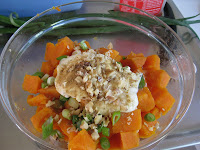Instead, I left my barbecuing until today, when I wandered up to the Mad Butcher after work and grabbed a pack of sirloin steaks. On arriving home, I mixed up some barbecue marinade (p190) and started on a kumara salad (p177).
The marinade (a simple mixture of tomato, soy and sweet chilli sauce, with garlic and sugar) took only a minute or two to throw together. I had a steak marinating and was chopping up my kumara when Mum and Dad dropped in. Since I had a couple more steaks, I talked them into staying for dinner.
I coated the other two steaks in marinade and put the kumara on to boil. This was to be cooked until "just tender" but I'm afraid I got distracted chatting to my parents and watching Masterchef: the kumara was a bit soft for salad purposes by the time I took it off the heat.
When the kumara had cooled down, I chopped it into chunks and added spring onion, mayonnaise, sour cream, a little curry powder, and some chopped walnuts. Stirring this through turned the kumara even more mushy, but never mind - it's not about how it looks, it's how it tastes, right?
I put the completed salad back in the fridge and took out the steaks. The barbecue had been heating up for around ten minutes, so I went and put the steaks on. I'm not very skilled at the art of steak cooking, so it's lucky none of us are terribly picky. I just cooked the steaks for as long as it took to throw together a green salad then took them off to rest.
The marinade on the steaks had scorched a bit - Mum tells me you're supposed to blot off the marinade before putting it on the barbecue. I'll have to remember that next time: I really didn't mind the charring taste-wise, but I hear it's not very good for you.
My steak and salad made a perfectly acceptable meal. Sure, the kumara was mushy, but it tasted a lot better than it looked. And while I felt my steak was a bit overcooked, the marinade gave it a lovely flavour. (Mum and Dad both politely claimed that their steaks were perfectly cooked. I doubt it, but they got eaten anyway!)
So if you're looking to have an "outdoor cooking experience" in the near future, don't overlook the Edmonds book as a source for ideas. The barbecue marinade is easy and tasty, and if you're sick of ordinary old potato salad, why not try a kumara one? Just try not to overcook the kumara!





























































